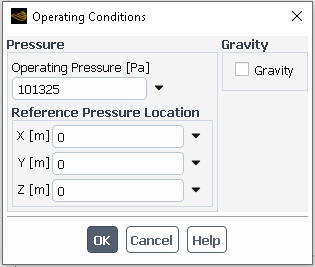The current Rocky formulation calculates buoyancy and additional pressure gradient forces based on pressure derivatives extracted from the CFD solutions, which are exported from Ansys Fluent. It is recommended, even in single-phase cases with constant properties, that gravity is turned on, and the reference density and pressure location are defined manually (assuming there are no boundary conditions defining pressure references). In the momentum equation solved by Ansys Fluent:
(7–1) |
the solution of the modified pressure field represents the static pressure variation due to the flow and the hydrostatic pressure at the reference density, as given by:
(7–2) |
By setting the reference density to 0 , all the hydrostatic contributions will be explicitly accounted within the
pressure solution and will be transferred to Rocky when you export the data. If the
simulation is stable, you may also set the reference pressure to 0 Pa. Although it is not
necessary, it allows you to have the absolute pressure including hydrostatic pressure to
post-process within Ansys Fluent and then later, within Rocky after the Fluent results are
imported.
Gravity, reference (operating) pressure, pressure reference location (if needed), and the specified operating density (reference density) can all be set up in the Operating Conditions dialog from the Cell Zone Conditions panel inside Ansys Fluent, as shown in Figure 7.1: Operating Conditions panel in Ansys Fluent.. Please check the Ansys Fluent documentation to find further information on the modified pressure and reference (operating) values. Some additional care should be taken when defining pressure boundary conditions (such as pressure outlets); in this way, specification of the correct pressure distribution (instead of a constant value) may be needed.
It is worth noting that Fluent does not save pressure gradient information in case or data files. This is important to be aware of because if a Fluent case is read from a simulation that was previously run and the solution is immediately exported to Rocky without performing an additional iteration, no pressure and velocity gradients will be available in the exported solution. To work around this, make sure that at least one CFD iteration is performed prior to exporting the solution to Rocky. Or export the CFD solution to Rocky right after the Fluent simulation is done, when the gradients are still available.
The heat transfer rate between a particle and fluid is calculated using the average convective heat transfer coefficient, the particle area, and the temperature difference between the particle and the fluid. The average convective heat transfer coefficient, by its turn, is computed based upon the Nusselt number that is calculated using the selected correlation within Rocky (more details can be found in Heat transfer). These correlations are a function of the particle Reynolds number and the Prandtl number. In order to compute these numbers, Rocky needs fluid properties, including fluid-specific heat and thermal conductivity.



